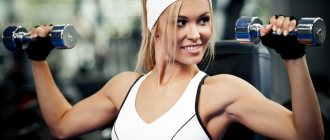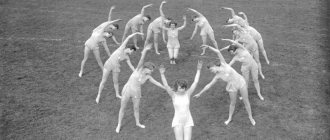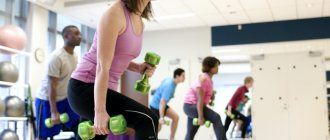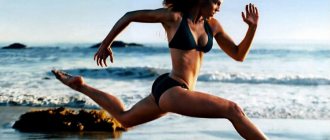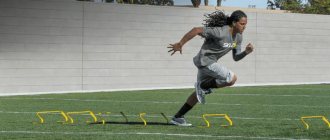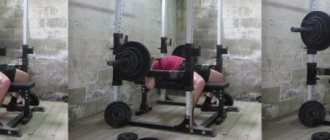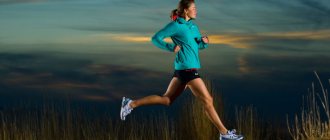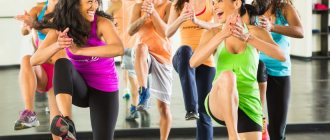Interval training is an effective exercise that is used both for professional athletes (swimmers, runners) and for sports enthusiasts. This method of training requires high energy expenditure and a fairly high level of physical fitness.
Interval training is based on alternating cycles of heavy, high-intensity physical work with short-term rest cycles or light loads. The main feature of this method is to carry out a larger volume of high-intensity work in less time. This becomes possible due to the presence of short periods of rest, during which the body has time to recover and continue the load at a high pace.
Why is it necessary to develop endurance in life?
First, let's define what is meant by endurance.
Endurance is the body’s ability to perform any work (physical, emotional, mental) for a long time without reducing performance. The level of endurance is determined by the amount of time that various activities can be performed. Simply put, endurance is the ability to withstand fatigue and decreased energy potential.
Many people believe that developing physical endurance is a necessity for athletes. However, I realized that this indicator affects our achievements in all areas of life. Increased endurance plays an important role in determining our performance, productivity and efficiency. And all these factors directly affect life in general. Therefore, endurance should be considered as a tool not only in relation to health, but also in relation to success.
Nothing stimulates endurance like an unbearable life!
Alexander Ratner
Success means having time to reveal your creative potential, realize yourself, and fulfill your mission. And for this you need to constantly move and overcome various life difficulties. All successful people are very resilient. And this is not an innate quality, it is only acquired.
And most of them were greatly influenced by playing sports. And it doesn’t matter what kind of activity they did. Any sport requires endurance. Just somewhere more, somewhere less.
It is very important to understand that our life is a whole marathon, which must be completed with optimal load and optimal speed. You won't be able to run to the limit here. You can burn out.
Every day you must become more resilient. Your endurance training will directly influence the achievement of your goals in life. Especially if you set ambitious goals for yourself. And I think that this is probably true!
In the course of developing physical endurance over several months, I achieved very interesting results. My sleep was reduced to 4 hours. The food was 80% raw food. In the morning there was clarity and high concentration of mind. My productivity has doubled. My body itself forced me to do various workouts. I was charged like an Energizer battery.
Then I realized that we know absolutely nothing about our body. And most people use their energy potential at about 30% of its potential. But why not learn to live to the fullest?! Make your life brighter and richer, where there is no place for lethargy and despondency, but where there is only energy, positivity and daily changes.
If you already have such a desire, then you need to know the following...
Restrictions and contraindications
Interval training classes involve heavy physical exertion, so the technique is contraindicated for people with serious diseases of the cardiovascular system and heart pathologies. If training rules are not followed, chronic diseases can worsen, and excessive loads can provoke a decrease in muscle volume and loss of strength. Interval training should be carried out under the strict supervision of a coach, and take into account the athlete’s level of preparedness.
Before starting classes, preliminary preparation with a moderate amount of physical activity is recommended. Preparation lasts from 2 to 12 months. Consultation with a doctor and trainer will also be useful. To ensure effective training, aerobic exercises are also conducted to adequately prepare the body for cardio.
Train your brain with fun
Develop memory, attention and thinking with the help of online simulators
START DEVELOPING
Special endurance is the body’s ability to endure long-term loads characteristic of a particular type of activity. Such endurance is a very complex and multicomponent motor quality. It is necessary to be selective in selecting the load for various exercises.
The level of development and manifestation of special endurance depends on a number of factors:
— general endurance;
— speed of resource consumption of intramuscular energy sources;
— the ability of an athlete to continue an exercise when tired due to the manifestation of volitional qualities is of particular importance;
- techniques for mastering motor action, associated with rationality, economy of technology and tactics, i.e. technical and tactical skill.
— capabilities of the neuromuscular system;
— speed capabilities (speed and flexibility of working muscles);
— coordination abilities (precision of movements);
— strength qualities and development of other motor abilities.
In turn, special endurance is divided into:
— high-speed:
— power:
— speed-power:
- coordination.
Speed endurance is characterized by the body’s ability to perform fast movements for a long time without fatigue or disruption of technique.
Strength endurance indicates the muscular ability to perform heavy exercise for a long time without visible technical impairment.
Coordination endurance presupposes the ability to perform complex exercises to coordinate motor actions for a long time and effectively.
And strength endurance, in turn, comes in two types:
— dynamic;
- static.
Dynamic strength endurance is characterized by performing heavy exercises at a relatively slow pace, but for a fairly long time.
Static strength endurance involves the ability not to change a position for a long period of time.
The choice of type of endurance depends on the goals that a person sets for himself.
Developing speed endurance has recently become my No. 1 priority. It’s just that our life is similar to the same marathon that athletes go through, only longer than the Olympic distance. And even if you don’t play sports professionally, you should still become an “athlete for life.” The only difference is that you have no other rivals except yourself.
Content
- 1 Interval training for fat loss 1.1 Benefits of interval training
- 3.1 Kettlebell or dumbbell swings
- 5.1 Tabata Protocol
Training to develop speed endurance
Cycling
The development of my physical endurance began when I bought myself a bicycle. Moreover, the reason for buying it was not the desire to become more resilient. I just wanted to balance out my sedentary lifestyle at the computer with some physical activity. And the choice fell on a bicycle, because... There were friends at work who had already been skating for several years. And in the very first year of riding, I realized that the bicycle was mine.
Freedom, new places and physical activity - a great combination that cycling can give everyone! In search of new adventures, the distance increased, and we began to travel outside the city more and more often. This required more endurance, which I could not boast of. Then I decided to purposefully conduct endurance training. What can you recommend in this regard?
You need to start riding a bike at a uniform and average speed of 15 km/h on flat terrain. The minimum distance must be 10 km. The heart rate during such training should be 50-60% of the maximum. Conduct training 2-3 times a week and 2-3 days between them for recovery. And then the speed should be increased to 25-30 km/h, the distance to 20-40 km, and the terrain should vary (from flat to mountainous with different surfaces).
Run
Having started to get involved in cycling, I became acquainted with the sport of Triathlon. And he really grabbed me. It is a multi-sport race, which consists of a continuous and sequential passage of 3 stages: swimming, cycling and running. There are different distances: sprint, Olympic, iron. Then I decided to set a goal - to someday run the Olympic distance (750m swimming + 40 km cycling + 10 km running).
To do this, I included endurance running in my training. In addition, conditions have developed that are conducive to this. My new apartment is located near a forest area that leads to the Central Park of the city of Voronezh. The distance to it is 2.5 km with ups and downs. Morning runs became a new challenge for me in my life, which over time turned into a pleasure.
I use both steady and variable running with accelerations. I constantly vary the distance depending on my mood, weather and body readiness: 2.5 km, 5 km or 10 km. For better time measurements, I run endurance races at the stadium. In addition to increasing physical endurance, developing the cardiovascular, respiratory and motor systems, strengthening muscles, I noticed a decrease in headaches. Therefore, I recommend starting to run both for endurance and to improve your overall health.
Swimming
While there are a lot of people around the world who are interested in running and cycling, there are much fewer people who are interested in swimming. But thanks to it, you can also improve your endurance. But for Triathlon you need to do this very seriously. But again, any open body of water will do for a start. I swim at our Voronezh reservoir in the area of the Gorky sanatorium. I swim distances from 100m to 1 km.
It is better to develop speed endurance for triathlon, of course, in the open air in the summer. In winter, for training, you will need to go to a fitness club, where there are treadmills, exercise bikes and a swimming pool. At home, unfortunately, you can’t develop speed endurance, but you can develop two other types (strength and coordination). They will also help in developing overall endurance.
I definitely decided to develop my endurance throughout my life, both for health and for success. Perhaps this video will motivate you too!
https://youtu.be/U2vd76pY00s
And in conclusion, I will share my experience, which will help increase your endurance several times!
How to swim correctly to lose weight?
Before starting training, you should purchase the necessary swimming equipment:
- Swimsuit - it is better to choose a one-piece and comfortable one that will not slide down during intense workouts;
- Cap - protects hair from the negative effects of chlorinated water;
- Glasses - will prevent chlorinated water from getting into your eyes. They should fit snugly to the face;
- Rubber slippers - you should choose non-slip ones.
Training in water for weight loss should be done correctly. First, you should do a 10-minute warm-up, which involves swimming freestyle, and then start interval training. Interval training promotes effective weight loss. It consists of alternating the most intense load and rest. Beginners are recommended to swim at full strength for 30 seconds, with 15 seconds of them performing the butterfly style, 15 seconds slower crawl and breaststroke. The next 30 seconds are allotted for rest and relaxation in the water.
Exercises in water
To lose weight, you can not only do interval training in water, but also exercise.
5 basic exercises for losing weight in water:
- Exercise 1: Stand up straight, keep your back straight, arms extended in front of you. Alternately raise your legs bent at the knees to the maximum height. This exercise is aimed at strengthening the buttocks and back of the thighs.
- Exercise 2: Immerse yourself in water. You need to lift your legs bent at the knees one by one and perform boxing movements with your hands. Trains the buttocks and biceps.
- Exercise 3: Lie on the water, with your head on an inflatable pillow or mattress. Use your feet to imitate riding a bicycle. The muscles of the legs, back and abs are involved.
- Exercise 4: Stand with your back to the side of the pool, grab it with your hands. Bring your legs together and pull them towards your chest, bending at the knees, then to the right and left sides. The leg muscles and oblique abdominal muscles are involved.
- Exercise 5: Immerse yourself in water up to your neck. Balancing with your hands on the water, with your legs bent at the knees, try to reach your buttocks one by one. An effective exercise for pumping the muscles of the thighs and buttocks.
Each exercise in the complex should be performed at least 20 times to lose weight.
Supplements for interval training[edit | edit code]
Research results
Translation from English and adaptation of the text: Andrei Zavyalov
Sports scientists at California State Polytechnic University have published a study showing that caffeine supplements and green tea extract promote increased calorie burning after exercise.
The study involved 12 athletes spending 3-5 hours in the gym or on the sports field. Subjects visited the research laboratory twice, where they completed 30 minutes of interval training on a stationary bicycle. The interval training consisted of a 5-minute warm-up followed by a 30-second sprint, followed by 5 minutes of light recovery exercise on a stationary bike. Subjects repeated this cycle—a short burst of high intensity followed by a load of low intensity—three times. In one case, subjects were given a placebo 45 minutes before exercise. On another occasion, they received a supplement containing 250 mg of caffeine and 400 mg of green tea extract. Green tea extract consisted of 50% EGCG (Epigallocatechin gallate) and contained only 5 mg of caffeine.
The athletes performed interval training early in the morning before breakfast. After a breakfast, especially a high protein breakfast, the body's enzymes neutralize almost all of the polyphenols in green tea before they take effect. If subjects had taken the supplement after breakfast, the effect of green tea would have been significantly lower.
results
In the 45 minutes before starting an interval workout, supplementation increased calorie burning by 8% and fat burning by 11%, as shown in the graph. Within 45 minutes of finishing the interval workout, the supplements increased calorie expenditure and fat burning by 10%, as shown in the graph. The supplements had no effect on heart rate (HR) or blood pressure. This is mainly because the subjects were habituated to caffeine: they consumed at least 200 mg of caffeine daily.
The results support the effectiveness of dietary caffeine and green tea polyphenols in supporting efforts to reduce body fat and improve overall fitness, especially when combined with high-intensity interval exercise.
